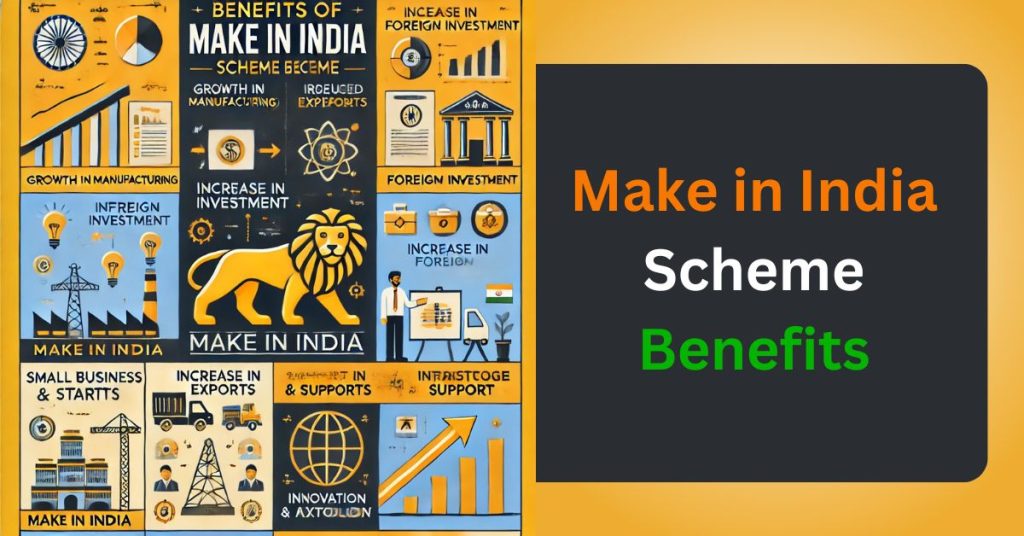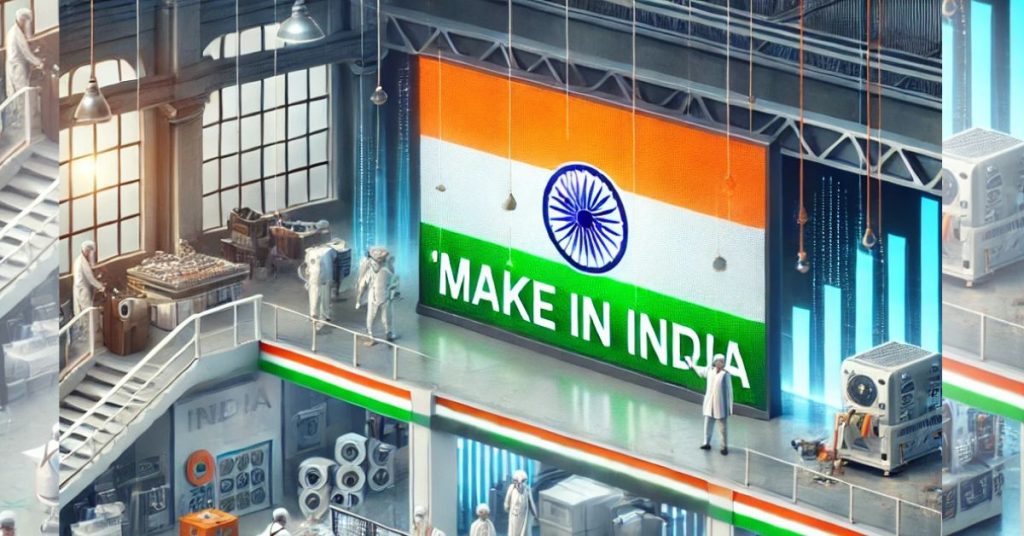India is one of the fastest-growing economies in the world. To make India a global manufacturing hub, the Indian government launched the Make in India scheme in 2014. This initiative encourages companies—both Indian and foreign—to manufacture products in India, creating jobs and boosting economic growth.
The Make in India scheme has brought many benefits to the country, including industrial growth, increased investments, job creation, and better infrastructure. Let’s explore these benefits in detail.
1. What is the Make in India Scheme?
The Make in India scheme is a government initiative launched by Prime Minister Narendra Modi on September 25, 2014. It aims to promote manufacturing and investment in India. The goal is to reduce dependence on imports and make India a self-reliant economy.
This scheme focuses on 25 key sectors, including automobiles, textiles, pharmaceuticals, electronics, defense, and renewable energy. The government offers various incentives, such as tax benefits and easier regulations, to attract businesses to set up manufacturing units in India.
In simple words, the government wants more products to be made in India instead of importing them from other countries. This will help businesses grow and create more job opportunities.
2. Growth in the Manufacturing Sector
One of the biggest benefits of the Make in India scheme is the growth of the manufacturing sector. Before this scheme, India’s economy was heavily dependent on services and agriculture. However, with Make in India, the government has taken steps to improve manufacturing by providing financial support, better infrastructure, and easier business policies.
The growth of manufacturing helps in making high-quality products that can be sold worldwide. This strengthens India’s position in the global market and increases its economic stability.
For example, India has now started making its own mobile phones, cars, and defense equipment, which were earlier imported from other countries. This saves money and reduces dependence on other nations.
3. Increase in Foreign Investment (FDI)
Foreign companies are now investing more money in India because of the Make in India scheme. The government has made it easier for foreign businesses to set up factories and offices in India by allowing 100% Foreign Direct Investment (FDI) in many sectors like defense, railways, and construction.
As a result, big companies from Japan, the USA, Germany, and other countries have invested billions of dollars in Indian industries. This not only helps businesses grow but also creates more job opportunities for Indians.
When foreign companies invest in India, it leads to the development of new technology, better products, and higher salaries for workers.
4. More Job Opportunities
With more factories and industries being set up in India, there has been a huge increase in job opportunities. The Make in India scheme has created millions of jobs in automobiles, textiles, electronics, construction, and many other industries.
This scheme is not only helping skilled workers like engineers and technicians but also unskilled workers who can get jobs in factories and manufacturing plants.
When people get jobs, they earn money, which helps improve their living standards and supports economic growth. This is one of the biggest benefits of the Make in India scheme.
5. Development of Better Infrastructure
To support industries and businesses, the government has invested a lot of money in building new roads, railways, ports, and power plants. This has improved transportation and electricity supply, making it easier for businesses to operate in India.
Some major projects under this scheme include:
- Industrial Corridors – Special areas where factories can be built with better roads and facilities.
- Smart Cities – Cities with modern technology, better transport, and improved living conditions.
- Dedicated Freight Corridors – Special railway lines to transport goods faster and cheaper.
Good infrastructure helps both businesses and common people by making transportation and communication easier.
6. Growth of Indian Startups and Entrepreneurs
The Make in India initiative has also encouraged Indian entrepreneurs and startups to start their own businesses. With better government support, funding opportunities, and simpler business regulations, many startups have been able to grow successfully.
For example, companies like Ola, Paytm, and BoAt have grown rapidly and are now competing with global brands.
When startups grow, they create more jobs and bring new ideas and technology to the market. This is good for the overall development of the country.
7. Reduced Dependence on Imports
Before the Make in India scheme, India imported a lot of goods from other countries, especially electronics, machinery, and defense equipment. This meant India had to spend a lot of money buying products from abroad.
Now, with the Make in India scheme, many of these products are being manufactured within India. This reduces the need for imports, saves foreign currency, and strengthens the Indian economy.
For example, India has started making its own smartphones, electric vehicles, and defense equipment, reducing its dependence on China and other countries.
8. Increase in Exports
As Indian industries have grown, the country has started exporting more products to other countries. Indian-made goods like pharmaceuticals, textiles, automobiles, and IT products are now being sold in international markets.
More exports mean more money for India, which helps improve the country’s economy. The government is also signing trade agreements with other nations to sell more Indian products globally.
This has made India one of the leading exporters in the world for many products.
9. Strengthening of Small Businesses (MSMEs)
Micro, Small, and Medium Enterprises (MSMEs) are very important for India’s economy. These small businesses create jobs and produce many goods.
The Make in India scheme has helped small businesses get loans, modern technology, and government support to expand their production.
With these benefits, small businesses can compete with larger companies, grow their market, and contribute to the economy.
10. Innovation and New Technology
The Make in India scheme has encouraged companies to invest in research and development (R&D). Many Indian industries are now using modern technology, artificial intelligence, and automation to improve their products and efficiency.
For example, India’s space agency ISRO has developed low-cost satellite technology that is now used by many countries. Similarly, Indian automobile companies are making electric cars and smart vehicles using advanced technology.
By focusing on innovation, India is becoming a leader in technology and science.
Conclusion
The Make in India scheme has played a crucial role in transforming India’s economy. It has boosted manufacturing, created jobs, attracted foreign investment, and improved infrastructure.
With continued efforts, India is on its way to becoming a self-reliant and globally competitive economy. By supporting Indian-made products and industries, we can contribute to the success of the Make in India initiative.
This scheme is not just for businesses—it benefits every Indian by creating more jobs, better products, and a stronger economy.
Let’s support Make in India and help build a stronger, self-reliant, and prosperous India!
Also Read:
- Top Make in India Companies
- Impact of Make in India on Indian Economy
- Advantages and Disadvantages of Make in India
- Challenges of Make in India
Frequently Asked Questions
What is the goal of the Make in India scheme?
The Make in India scheme aims to boost manufacturing, create jobs, and attract investments. It encourages companies to produce goods in India, reducing imports and strengthening the economy. The goal is to make India a global manufacturing hub and increase self-reliance in various industries.
How does Make in India create job opportunities?
By encouraging manufacturing, the scheme attracts companies to set up factories in India. This creates jobs for skilled and unskilled workers in industries like automobiles, textiles, electronics, and construction. More businesses mean more employment, improving people’s income and overall living standards in the country.
How does Make in India benefit small businesses?
The scheme supports small businesses (MSMEs) by providing financial aid, loans, and access to better technology. It helps them grow, compete with larger companies, and expand their market. With government assistance, small businesses can increase production and contribute to India’s economic development.
How does Make in India attract foreign investments?
The government has allowed 100% Foreign Direct Investment (FDI) in many sectors, making it easier for foreign companies to set up industries in India. This brings money, technology, and job opportunities, helping India’s industries grow and compete globally while improving infrastructure and the economy.
What are the challenges of Make in India?
Some challenges include slow implementation, lack of skilled workers, infrastructure issues, and competition from countries like China. The government is working to improve policies, education, and infrastructure to overcome these challenges and make India a strong global manufacturing hub.




